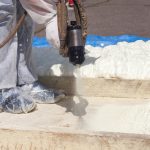Military Grade Foam is Used in Countless Defense Applications
With Veterans Day around the corner, we wanted to take this opportunity to thank veterans for their service. Your time, energy, and sacrifices are deeply appreciated, and we’re grateful to you for all that you do to keep our nation safe. We also wanted to take the opportunity to share ways that our equipment plays an important part in numerous military grade foam applications.
Polyurethane is a common material across the various branches of the U.S. Armed Forces. For example, Linden Polyurethane is proud to be a U.S.-certified supplier for the U.S. Navy, where military grade foam is used in a variety of applications that include aircraft carrier insulation and construction, explosive blast protection, weapon insulation and transportation protection, and even underwater robotics.
In other branches, polyurethane foam is used for a variety of needs such as building insulation, structural and vehicular noise reduction, seat cushions and padding, helmets, and a variety of parts used in weapons and other gear. For aircraft, polyurethane is used for exterior coatings due to its vast temperature resistance and noise reduction capabilities.
Across the board, military grade foam is chosen because steel, plastics, and other materials can’t provide the same properties, are too expensive, or won’t hold up in harsh environments. Whereas steel is heavy and can rust and plastics are brittle and can’t withstand high temperatures or corrosive environments, polyurethane can be engineered to be lightweight and impenetrable to water — and for much less than steel.
But what does it take to create the ideal military grade foam? It all starts with having the right polyurethane processing equipment. While production environments differ and steps to produce material vary by application, we’ve identified four key equipment types that influence material performance.
Four Equipment Types That Contribute to Successful Military Grade Foam
While there are multiple machines involved in the production of military grade foam, they can be grouped into two areas of importance: blending and distribution.
Blending: Bulk Blending and Gas Nucleation
Achieving the right material properties starts at the chemical level. To support this important part of the process, two machines should be used. The first is a bulk blending solution. Often connected to a bulk storage tank, bulk blending equipment is capable of handling a variety of chemicals and other additions to your polyurethane blend, including colors, fillers, and blowing agents. These can be mixed directly with the polyol or in line to maximize efficiency during production. Using a bulk blending solution prevents waste and excess costs and ensures your material has the properties it needs.
Learn more about the bottom-line benefits of bulk blending equipment.
Another important blending solution is gas nucleation equipment. Also called gas infusion, there are two common equipment types companies supporting military applications can use. The first is a carbon dioxide infusion system, which manages the homogenous dissolution and distribution of C02 into the polyurethane formulation. This helps to reduce chemical costs (often by up to 20%), reduce weight, improve sound-related properties, and more. The other is a dry air/nitrogen infusion system, which improves wet-ability, mixing quality, and material flow while eliminating surface defects, improving molding geometry, and preventing streaks.
Learn more about the benefits of gas nucleation: Improve Polyurethane Foam Cell Structure with Gas Nucleation
Distribution: Metering Systems and Mix Heads
The metering system is the heart of any polyurethane production environment. These advanced and highly customizable systems regulate the flow of material from your storage solutions to the mix head, ensuring the right amount of material is moving from A to B. With the correct system, material moves through the production process seamlessly. Depending on the application, mold type, and volume of material needed, high-pressure systems (ideal for part production in high and low volumes) and low-pressure systems (ideal for coatings for a variety of surfaces and components) are available.
Learn how the right output requires the right metering system: Polyurethane Metering Systems: Customization is Critical
Last but certainly not least is the polyurethane mix head. This is where the effort of all previous equipment and processes comes together to be distributed into a mold, sprayed, or otherwise dispersed for the application at hand. There are a variety of mix heads available to support your military grade foam application, but the end product and performance requirements influence what mix head is needed. For example, L-style mix heads bring material together at a 90º angle — ensuring it mixes more thoroughly while also slowing its velocity prior to exiting the mix head. This is critical for a variety of foam types, but especially in applications such as insulation where the material needs to retain its shape and provide high R-values.
Learn more about the importance of choosing the right mix head: The Key to Mixing Polyurethane: Precision and Consistency
Use the Best for Your Production Environment
We understand how important getting the right mixture is in your polyurethane application. Since 1985, Linden Polyurethane has been custom designing, engineering, installing, and maintaining world-class production equipment for military applications and countless others, such as aerospace, automotive, and construction. Wherever polyurethane is used to protect people, make products stronger, and create better working environments, we’ll be there, too.
If you’ve been looking for a partner to support your military grade foam needs, our full line of bulk storage and blending solutions, metering systems, mix heads and pumps, gas infusion systems, and other equipment cover your entire production chain from end to end. And it’s all supported by a best-in-class warranty and repair program and customer support team that’s available to you 24/7/365.
Contact us today to learn more about our equipment and capabilities.
Please join us in honoring our nation’s heroes this Veterans Day, November 11, 2020.





